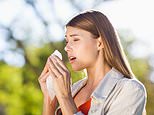A ‘pollen bomb’ is forecast over the Easter weekend
Bad news for hay fever sufferers! A ‘pollen bomb’ is forecast over the Easter weekend with cities including London, Leicester and Nottingham experiencing the ‘highest levels of the year’
- The new Kleenex Pollen Forecast looks at pollen counts on a per postcode level
- They say this will help those with hay fever better plan any time spent outdoors
- The forecast warns of particularly high levels of tree pollen across the UK
Hay fever sufferers may want to stay indoors this weekend as forecasters warn of a ‘pollen bomb’ bringing with it some of the highest levels of tree pollen this year.
The warning comes from Kleenex and Allergy UK, who have launched a new ‘Pollen Pal’ tool, giving a three day pollen count forecast to help hay fever sufferers.
London, Leicester and Nottingham will be among the worst affected, with almost twice the concentration of pollen as will be seen in other ‘high pollen’ regions.
The Met Office, which produces a regional forecast for the UK says their data suggests a low to medium pollen count for most of the country this weekend.
In contrast, data from the new Kleenex Pollen Forecast, launched today, and taking more local data per postcode, shows that pollen levels across the country this weekend will be high, especially for tree pollen.


London, Leicester and Nottingham will be among the worst affected, with almost twice the concentration of pollen as will be seen in other ‘high pollen’ regions


Hay fever sufferers may want to stay indoors this weekend as forecasters warn of a ‘pollen bomb’ bringing with it some of the highest levels of tree pollen this year
There are thought to be 13 million hay fever sufferers in the UK with varying levels of sensitivity to different pollen types who would benefit from a regular forecast.
Allergy UK say sufferers planning to go out to enjoy the long Easter weekend should wear a hat, use an allergen barrier balm and carry a packet of tissues with them.
This isn’t surprising as we are about to move towards peak pollen season, but the forecasters say tree pollen readings are forecasted to be particularly high.
The severity of pollen levels is measured by Pollen Grains Per Cubic Metre (PPM), where a reading of 200-703 for tree pollen is considered high, and anything above 704 very high, Allergy UK explained.
The Kleenex Pollen Forecast, that supplied the Pollen Bomb warning, is one of the most regionally accurate pollen tracking tools available, the firm claims.
It provides a detailed pollen count for all 1.7 million postcodes across the UK three days in advance.
Kleenex says this enables those with hay fever to plan days out using pollen data specific to their local town or city, rather than a broad national forecast.
However, when asked about the discrepancy between their relatively low to mid-level pollen count and the high forecast from Kleenex, the Met Office said it could be down to differences in the types of pollen traps used.
The Met Office said several companies in the UK use American traps that have been found to produce suspect data as they don’t use standard counting methods.
A spokesperson said the pollen season hasn’t properly started yet and the forecast for the weekend is relatively cool, so shouldn’t have a big impact on hay fever.


London is showing a high tree pollen forecast, although other pollen types are not expected to be high this Easter weekend
The data is sourced from Ambee, which collates information from pollen traps across the country.
They also look at local weather on the day and on different types of trees, weeds and grass in a specific area.
‘The Kleenex Pollen Forecast offers unrivalled insight into local pollen levels and should be a big help for anyone struggling with allergies,’ said Ori Ben Shai, Vice President and Managing Director, Kimberly-Clark UK, makers of Kleenex.


The warning comes from Kleenex and Allergy UK, who have launched a new ‘Pollen Pal’ tool, giving a three day pollen count forecast to help hay fever sufferers
‘We recommend that anyone with hay fever symptoms check pollen levels in their postcode daily to ensure they can prepare appropriately.
He added they ‘need not hide inside while the sun is shining.’
The launch of the Pollen Forecast comes as Kleenex renews its partnership with Allergy UK to help support the UK’s hay fever sufferers through peak allergy season.
The partnership funding will allow Allergy UK to divert extra resource towards its helpline to ensure those really struggling with their symptoms are able to access expert support and guidance.
Amena Warner, Head of Clinical Services, Allergy UK, said: ‘Despite the expected spike in pollen levels this Good Friday, most hay fever is manageable if you take the necessary steps to prepare yourself.’
Warner said there are a number of measures sufferers can take to minimise symptoms if they do decide to go out in the spring sunshine.
‘Consider your wardrobe choices,’ she said, adding ‘accessories like hats and wraparound sunglasses can stop pollen from reaching face, hair and eyes.’
Allergy UK advise sufferers try using an allergen barrier balm around the base of the nostrils and around sunglasses, as it creates a barrier to airborne allergens.
‘Schedule your daily outings carefully Always check the Kleenex™ Pollen Forecast before leaving the house,’ said Warner.
‘Monitoring pollen levels daily can help you plan ahead to manage your symptoms.’
They also recommend always carrying a pack of tissues, adding that the ‘Kleenex Allergy Comfort tissues hold the Allergy UK Seal of Approval and are designed to be gentle and ultra-absorbent for use around watery eyes and runny noses.’
![]()


